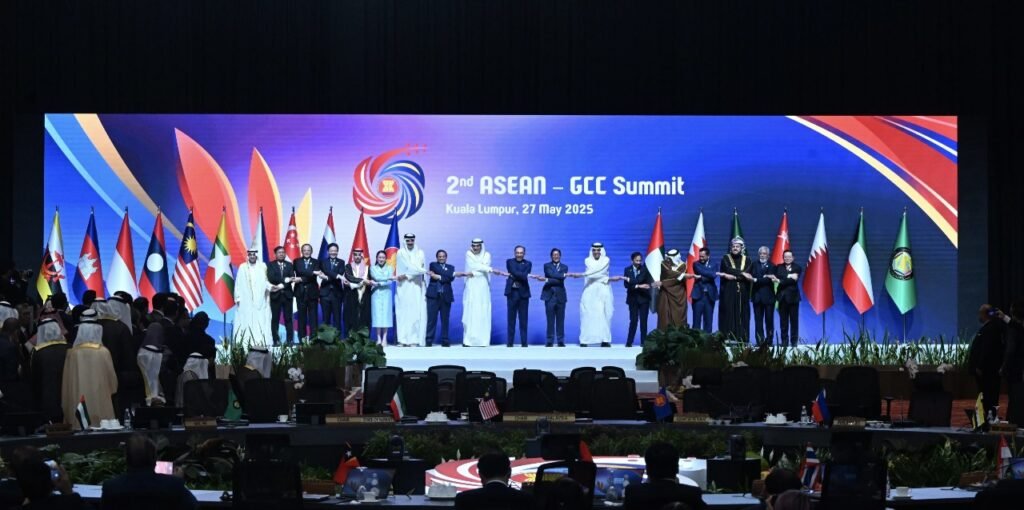On May 27, 2025, in the humid capital of Malaysia, a quiet but potentially world-changing moment unfolded. For the first time, three major regions—Southeast Asia, the Arab Gulf, and China—came together at a single table. It wasn’t a flashy event, but the message was clear: the world’s center of gravity is shifting, and the Global South wants a stronger voice.
According to Joint Statement of the ASEAN-China-GCC Summit, The gathering brought together ASEAN, the Gulf Cooperation Council (GCC), and China—representing nearly two billion people and a combined economy worth almost $25 trillion. That’s roughly a quarter of the world’s population and economic output. Numbers like that are hard to ignore.

A Summit Rooted in Change
This wasn’t just about diplomatic pleasantries. The reasons behind the summit go deeper. The Gulf countries, long dependent on oil, are pushing to modernize and diversify their economies. ASEAN nations are looking outward, aiming to become more influential as a collective. And China, already a global heavyweight, sees this triangle as a way to strengthen its influence across Asia and the Middle East.
In many ways, the summit was driven by necessity. Oil revenues are no longer a guarantee. Global trade patterns are changing. And a new kind of economic and political alignment is starting to take shape—one that doesn’t revolve around Washington or Brussels.
Economic Integration
- The three respective actors are committed with sustainable development, mutual alliance etc. ASEAN and GCC, to facilitate the attainment of the United Nations 2030 Agenda for Sustainable Development and also was welcomed by the conclusion of ASEAN- CHINA FTA 3.0.
- Exploring regional financial cooperation, including capital markets, and financial technology among others.
- Empowering micro, small, and medium enterprises (MSMEs). Exploring cooperation on local currency and cross-border payments.
What They Agreed On
According to AP News, The summit ended with a joint statement that focused on shared values and long-term cooperation. But underneath the formal language were clear goals.
First, the three sides want closer economic integration. That includes improving trade ties, supporting small businesses, and finding ways to trade using local currencies instead of relying on the U.S. dollar. ASEAN and China have already upgraded their free trade agreement, and similar talks with the GCC are expected to follow.
Infrastructure was another major theme. The group discussed better transport routes, digital infrastructure, and more coordinated logistics across regions. China’s Belt and Road Initiative was front and center, with plans to extend it further into Southeast Asia and the Gulf.
There was also a strong push on technology. The summit highlighted the importance of joint work in artificial intelligence, quantum computing, and smart cities—fields that could shape the global economy over the next decade.
Food and education weren’t left out either. The leaders talked about greater collaboration on halal food standards and more student exchanges, particularly in science and engineering. These people-to-people ties may not grab headlines, but they build trust over time.

How Big Is This Really?
Let’s put things in perspective.
| Bloc | Population | Economic Size |
|---|---|---|
| China | 1.4 billion | $19.3 trillion |
| ASEAN | 680 million | $3.6 trillion |
| GCC | 60 million | $2 trillion |
| Combined | ~2 billion | $24.9 trillion |
If this grouping sticks together, it could become one of the most powerful economic forces in the world. It’s already bigger than the European Union in population and not far behind in trade.
A Challenge to the U.S.?
The summit has reflected combined US Dollars of 24.9 trillion representing around 22- 25 % of global economic output. Almost 2 billion people roughly around 27% of world population has been reflected. The scale could be understood in this sense that all the respective countries are the part of fastest growing economies in the world.
While no one at the summit openly talked about the United States, the subtext was hard to miss. Calls for local currency trade and regional financial systems are signs of frustration with Western-dominated institutions. This isn’t just about money—it’s about independence.
China, in particular, sees this as a moment to present itself as a reliable partner, in contrast to the inward-looking politics seen in parts of the West. Premier Li Qiang spoke of a future ASEAN–GCC–China free trade zone—one that could become one of the largest markets in the world.
The summit also gave China a chance to distance itself from the heavy-handed image it’s earned in some parts of the world. This was soft power in action: a quiet, calculated move to show that China can work cooperatively with both Islamic countries and its Southeast Asian neighbors.

Not Without Its Problems
Still, it’s far from perfect. Within ASEAN, trade between member states remains relatively low. That weakens the bloc’s internal strength. In the Gulf, countries are still figuring out how to move beyond oil, and the path isn’t always smooth. China, meanwhile, is dealing with its own issues—slower growth, rising debt, and pressure from an aging population.
Then there’s the question of coordination. ASEAN and China have been working together on trade for over 20 years. The GCC, on the other hand, has never signed a formal trade deal with ASEAN. There’s no guarantee that everyone will be on the same page, and bringing 17 countries with different agendas into alignment is no small task.
Malaysia’s Role Behind the Scenes
This summit didn’t happen by accident. Malaysia played a quiet but important role in bringing the parties together. As a Muslim-majority country in Southeast Asia with good ties to both China and the Arab world, it was in a unique position to act as a bridge. Kuala Lumpur didn’t just host the event—it shaped its tone and direction.
For Malaysia, this was more than just diplomacy. It was a strategic bet on the future of Asia.
Too Soon to Call It a Superpower Bloc
It’s tempting to see this summit as the birth of a new super-alliance. But that would be jumping the gun. One meeting doesn’t change the world overnight. Real alliances are built over years—through trade, trust, and shared experience.
Still, the direction is clear. These regions are tired of sitting on the sidelines of global decision-making. They want a seat at the table—and increasingly, they’re building their own.
Read More: What’s Inside Israel’s ‘Box of Surprises’ Arsenal For Iran?
Watch India Pakistan Breaking News on The Ink Post. Get Latest Updates, Latest News on Movies, Breaking News On India, World, Explainers.
Follow us on Facebook and Instagram and LinkedIn and Twitter to Stay updated!




